
168 Results

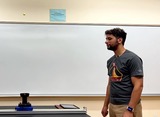
Video demonstration experiments show the laws and concepts in action.
- Subject:
- Physical Science
- Physics
- Material Type:
- Activity/Lab
- Diagram/Illustration
- Module
- Unit of Study
- Author:
- Ryan Carmichael
- Geoffrey Franceschi
- Tatiana Erukhimova
- Dawson Nodurft
- Nicole Cirigioni
- Date Added:
- 09/12/2022

A mixture of multiple-choice and free-response problems aimed at developing critical thinking. Detailed solutions to all problems are provided.
- Subject:
- Physical Science
- Physics
- Material Type:
- Diagram/Illustration
- Homework/Assignment
- Module
- Student Guide
- Teaching/Learning Strategy
- Unit of Study
- Author:
- Ryan Carmichael
- Dawson Nodurft
- William Bassichis
- Rainer Fries
- Jeremy Holt
- Tatiana Erukhimova
- Arthur Alvarez
- Nathan Brady
- Cole Reynolds
- Date Added:
- 09/12/2022

Problem-Solving Videos present detailed solutions to multi-step questions. These videos are structured to improve problem-solving skills.
- Subject:
- Physical Science
- Physics
- Material Type:
- Diagram/Illustration
- Lecture
- Module
- Student Guide
- Teaching/Learning Strategy
- Unit of Study
- Author:
- Ryan Carmichael
- Tatiana Erukhimova
- Carlee Garrett
- Date Added:
- 09/12/2022

Review Videos summarize major topics. This resource incorporates explanations, derivations, and demonstrations to illustrate a concept.
- Subject:
- Physical Science
- Physics
- Material Type:
- Diagram/Illustration
- Lecture
- Module
- Student Guide
- Teaching/Learning Strategy
- Unit of Study
- Author:
- Ryan Carmichael
- William Bassichis
- Tatiana Erukhimova
- Date Added:
- 09/12/2022


Video demonstration experiments show the laws and concepts in action.
- Subject:
- Physical Science
- Physics
- Material Type:
- Activity/Lab
- Diagram/Illustration
- Module
- Unit of Study
- Author:
- Ryan Carmichael
- Geoffrey Franceschi
- Tatiana Erukhimova
- Dawson Nodurft
- Nicole Cirigioni
- Date Added:
- 09/12/2022

A mixture of multiple-choice and free-response problems aimed at developing critical thinking. Detailed solutions to all problems are provided.
- Subject:
- Physical Science
- Physics
- Material Type:
- Diagram/Illustration
- Homework/Assignment
- Module
- Student Guide
- Teaching/Learning Strategy
- Unit of Study
- Author:
- Ryan Carmichael
- Dawson Nodurft
- William Bassichis
- Rainer Fries
- Jeremy Holt
- Tatiana Erukhimova
- Arthur Alvarez
- Nathan Brady
- Cole Reynolds
- Date Added:
- 09/12/2022

Problem-Solving Videos present detailed solutions to multi-step questions. These videos are structured to improve problem-solving skills.
- Subject:
- Physical Science
- Physics
- Material Type:
- Diagram/Illustration
- Lecture
- Module
- Student Guide
- Teaching/Learning Strategy
- Unit of Study
- Author:
- Ryan Carmichael
- Tatiana Erukhimova
- Carlee Garrett
- Date Added:
- 09/12/2022

Review Videos summarize major topics. This resource incorporates explanations, derivations, and demonstrations to illustrate a concept.
- Subject:
- Physical Science
- Physics
- Material Type:
- Diagram/Illustration
- Lecture
- Module
- Student Guide
- Teaching/Learning Strategy
- Unit of Study
- Author:
- Ryan Carmichael
- William Bassichis
- Tatiana Erukhimova
- Date Added:
- 09/12/2022
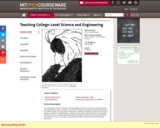
How does one teach science and engineering at the college level? It can be a daunting question, particularly for newly minted PhDs, but this rather fine course from the OpenCourseWare initiative at MIT offers high-quality suggestions. The site includes a syllabus, calendar, readings, video discussions, assignments, and other related resources. In the Syllabus area, visitors can learn about the basic lesson plans for the course. The Readings area has some great material, including sections on Teaching Equations, Course Design, Lecture Planning and Performing, and Political Barriers To Educational Change. Visitors should look over the Video Discussions area, which includes conversations with Professor Sanjoy Mahajan about the material. Finally, the site includes links to helpful books and other materials that will be most useful for those seeking further edification.
- Subject:
- Chemistry
- Education
- Engineering
- Physical Science
- Material Type:
- Diagram/Illustration
- Lesson Plan
- Provider:
- MIT
- Provider Set:
- MIT OpenCourseWare
- Author:
- Mahajan, Sanjoy, 1969-
- Date Added:
- 05/16/2013
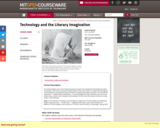
Our linked subjects are (1) the historical process by which the meaning of technology has been constructed, and (2) the concurrent transformation of the environment. To explain the emergence of technology as a pivotal word (and concept) in contemporary public discourse, we will examine responses--chiefly political and literary--to the development of the mechanic arts, and to the linked social, cultural, and ecological transformation of 19th- and 20th-century American society, culture, and landscape.
- Subject:
- Career and Technical Education
- Ecology
- Engineering
- Environmental Engineering
- Language, Philosophy, and Culture
- Life Science
- Literature
- Manufacturing
- Material Type:
- Full Course
- Provider:
- MIT
- Provider Set:
- MIT OpenCourseWare
- Author:
- Leo
- Marx
- Rosalind
- Williams
- Date Added:
- 01/01/2008
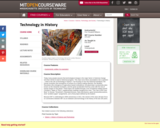
Today many people assume that technological change is the major factor in historical change and that it tends to lead to historical progress. This class turns these assumptions into a question "what is the role of technology in history?" by focusing on four key historical transitions: the human revolution (the emergence of humans as a history-making species), the Neolithic Revolution (the emergence of agriculture-based civilizations); the great leap in productivity (also known as the industrial revolution), and the great acceleration that has come with the rise of human empire on the planet. These topics are studied through a mix of textbook reading (David Christian's Maps of Time"), supplementary readings (ranging from Auel, "The Clan of the Cave Bear" to Hersey, "Hiroshima"), illustrated lectures, class discussions, guest lectures/discussions, short "problem paper" assignments, and a final project defined by the student. Because MIT is celebrating its 150th anniversary in 2011, this version of the class will also focus on connections between MIT as an institution and technology in the history of the last 150 years. "
- Subject:
- Creative and Applied Arts
- Material Type:
- Full Course
- Provider:
- MIT
- Provider Set:
- MIT OpenCourseWare
- Author:
- Williams, Rosalind
- Date Added:
- 01/01/2011
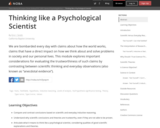
Text and links to all ancillary materials for Module 2
- Subject:
- Psychology
- Social and Behavioral Sciences
- Material Type:
- Module
- Reading
- Teaching/Learning Strategy
- Author:
- Erin I
- Date Added:
- 05/28/2021
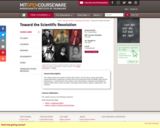
The emergence of Western science: the systematization of natural knowledge in the ancient world, the transmission of the classical legacy to the Latin West, and the revolt from classical thought during the scientific revolution. Examines scientific concepts in light of their cultural and historical contexts.
- Subject:
- Astronomy
- Language, Philosophy, and Culture
- Physical Science
- Physics
- World Cultures
- Material Type:
- Full Course
- Provider:
- MIT
- Provider Set:
- MIT OpenCourseWare
- Author:
- Kaiser, David
- Date Added:
- 01/01/2003

Design, operation, and management of traffic flows over complex transportation networks. Covers two major topics: traffic flow modeling and traffic flow operations. Deterministic and probabilistic models, elements of queueing theory, and traffic assignment. Concepts are illustrated through various applications and case studies.
- Subject:
- Engineering
- Environmental Engineering
- Material Type:
- Full Course
- Provider:
- MIT
- Provider Set:
- MIT OpenCourseWare
- Author:
- Chabini, Ismail; Odoni, Armedeo R.
- Odoni, Amedeo R.
- Date Added:
- 01/01/2002

University Physics is a three-volume collection that meets the scope and sequence requirements for two- and three-semester calculus-based physics courses. Volume 1 covers mechanics, sound, oscillations, and waves. Volume 2 covers thermodynamics, electricity and magnetism, and Volume 3 covers optics and modern physics. This textbook emphasizes connections between theory and application, making physics concepts interesting and accessible to students while maintaining the mathematical rigor inherent in the subject. Frequent, strong examples focus on how to approach a problem, how to work with the equations, and how to check and generalize the result.
- Subject:
- Physical Science
- Physics
- Material Type:
- Textbook
- Author:
- Alice Kolakowska
- Bill Moebs
- Daniel Bowman
- David Anderson
- David Smith
- Dedra Demaree
- Edward S. Ginsberg
- Gerald Friedman
- Joseph Trout
- Kenneth Podolak
- Kevin Wheelock
- Lee LaRue
- Lev Gasparov
- Mark Lattery
- Patrick Motl
- Richard Ludlow
- Samuel J. Ling
- Takashi Sato
- Tao Pang
- Date Added:
- 08/03/2016

University Physics is a three-volume collection that meets the scope and sequence requirements for two- and three-semester calculus-based physics courses. Volume 1 covers mechanics, sound, oscillations, and waves. Volume 2 covers thermodynamics, electricity and magnetism, and Volume 3 covers optics and modern physics. This textbook emphasizes connections between theory and application, making physics concepts interesting and accessible to students while maintaining the mathematical rigor inherent in the subject. Frequent, strong examples focus on how to approach a problem, how to work with the equations, and how to check and generalize the result.
- Subject:
- Physical Science
- Physics
- Material Type:
- Textbook
- Author:
- Jeff Sanny
- Samuel J. Ling
- William Moebs
- Date Added:
- 08/13/2020

University Physics is a three-volume collection that meets the scope and sequence requirements for two- and three-semester calculus-based physics courses. Volume 1 covers mechanics, sound, oscillations, and waves. Volume 2 covers thermodynamics, electricity and magnetism, and Volume 3 covers optics and modern physics. This textbook emphasizes connections between theory and application, making physics concepts interesting and accessible to students while maintaining the mathematical rigor inherent in the subject. Frequent, strong examples focus on how to approach a problem, how to work with the equations, and how to check and generalize the result.
- Subject:
- Physical Science
- Physics
- Material Type:
- Textbook
- Author:
- Jeff Sanny
- Samuel Ling
- Date Added:
- 08/13/2020
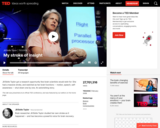
Jill Bolte Taylor got a research opportunity few brain scientists would wish for: She had a massive stroke, and watched as her brain functions — motion, speech, self-awareness — shut down one by one. An astonishing story.
- Subject:
- Psychology
- Social and Behavioral Sciences
- Material Type:
- Case Study
- Author:
- Jill Bolte Taylor
- Date Added:
- 05/21/2021